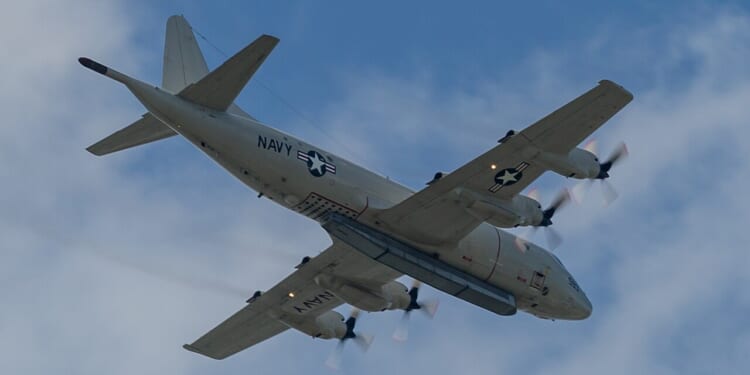Argentina’s purchase of the P-3C Orion patrol plane will give America’s strongest ally in Latin America a greater ability to defend itself from unwanted Chinese influence.
The Argentine Navy is in the final stages of preparing to receive its second P-3C Orion maritime patrol aircraft from the United States. This aircraft, identified by its tail number “3297,” was removed from storage at Davis-Monthan Air Force Base—the “Boneyard”—in December of last year, and has since been prepared for delivery. The handover is set to take place in the United States, marking a continuation of efforts to modernize Argentina’s naval aviation fleet.
This follows the arrival of the first P-3C Orion earlier this year, with a third unit projected for the first half of next year, and a fourth, a P-3N variant, expected later next year.
Transferring these aircraft to Argentina’s Armed Forces is part of a congressionally-approved deal to bolster Argentina’s maritime capabilities. Further, Argentine Naval Aviation is awaiting approval for associated weapons systems to fully operationalize these planes. The P-3C Orion deal represents a marked increase in relations with Argentina and real effort to bolster the embattled government of Javier Milei, the right-wing libertarian leader of the country.
The US Wants Argentina as a Partner Against China
By transferring these planes to Argentina, Washington hopes to counter China’s growing influence in Latin America, in keeping with President Donald Trump’s stated commitment to restoring the primacy of the United States in the Western Hemisphere.
For many years since the end of the Cold War, as America has fixated on the Middle East and now increasingly Europe, it has neglected their own part of the world. This has created cleavages for the Chinese, as well as the Russians and even the Iranians, to exploit. Trump has declared his intention to roll back Chinese influence in the region, and Milei’s Argentina plays a decisive role in this mission.
Milei is something of an ideal partner for Trump, as a libertarian and a fierce anti-communist who believes strongly in American ideals. Since he took power in Argentina, that country’s armed forces have taken a strong stance against the presence of Chinese fishing fleets that are illegally operating in Argentine waters. This deal is aimed at giving Argentina more capabilities to complicate similar Chinese efforts.
Historically, US arms transfers to Latin America have promoted interoperability with allied forces, prevented arms races, and enhanced diplomatic leverage, as seen in past policies that balanced security assistance with trade incentives. In this case, it reinforces US influence in a region where competition with powers like China and Russia is intensifying, while aiding Argentina’s sovereignty could stabilize South American geopolitics and open avenues for joint operations or training.
How the P-3C Orion Strengthens Argentina’s Defense
- Year Introduced: 1962
- Number Built: 757 (650 by US, 107 by Japan)
- Length: 116 ft 10 in (35.6 m)
- Wingspan: 99 ft 8 in (30.37 m)
- Weight: 142,000 lbs (64,410 kg) MTOW
- Engines: Four Allison T56-A-14 turboprop engines, each producing 4,910 shp
- Top Speed: 473 mph (761 km/h) at 15,000 ft
- Range: ~1,550 mi (2,500 km); 12 hours, 20 minutes’ endurance
- Service Ceiling: 28,300 ft (8,625 m)
- Loadout: 10 hardpoints, 8 internal bomb bay stations; 20,000 lb payload capacity; can carry missiles, bombs, and torpedoes; equipped with advanced avionics for threat detection
- Aircrew: 11 (including pilots, mission specialists, and sensor operators)
The P-3C Orion, being an advanced, long-range surveillance bird features advanced sensors, including magnetic anomaly detection (MAD) equipment, sonobuoys, and radar systems for detecting submarines and surface vessels. These planes carry a mixed payload of torpedoes, depth charges, mines, and missiles internally and on wing pylons. The aircraft is known for its endurance, making it ideal for long-range patrols.
Adding another Orion to Argentina’s small but growing fleet enhances Argentina’s long-range maritime patrol, surveillance, anti-submarine (ASW), and anti-surface warfare (ASuW) capabilities, particularly in the South Atlantic region. The P-3C is well-suited for monitoring Argentina’s extensive exclusive economic zone (EEZ), conducting fisheries surveillance, combating illegal fishing, and protecting natural resources, which are critical for national sovereignty and economic security.
The deal represents a step toward revitalizing Argentina’s aging fleet, replacing non-operational older models like the P-3B and improving overall maritime defense amid regional challenges such as illegal activities in territorial waters.
On a broader scale, the transfer under the Milei administration signals a real strengthening of Argentina’s military posture and alignment with Western partners, especially as the country faces economic pressures and seeks to modernize its forces.
Argentina Might Not Be on Trump’s Side Forever
These specs make the P-3C a versatile platform and will give America’s strongest ally in Latin America a greater ability to defend itself, and the Western Hemisphere, from unwanted Chinese influence.
But Washington must be careful. Latin America as a whole is now trending in the direction of left-wing governments—the so-called “pink tide.” Although Argentina has so far dodged this phenomenon, the Milei government is hanging by a proverbial thread.
In attempting to support its ideological allies in South America, the Trump administration has been burned before. For instance, during his first term, the then-45th president offered extensive support to the right-wing government of Jair Bolsonaro in Brazil. When Bolsonaro lost power to leftist leader Luiz Inacio “Lula” da Silva in 2022, the resources America had poured into Brazil suddenly became hostile to US interests. Should Argentina’s government go the same way as Brazil’s did, Trump may come to regret his largesse.
About the Author: Brandon J. Weichert
Brandon J. Weichert is a senior national security editor at The National Interest. Recently, Weichert became the host of The National Security Hour on America Outloud News and iHeartRadio, where he discusses national security policy every Wednesday at 8pm Eastern. He is also a contributor at Popular Mechanics and has consulted regularly with various government institutions and private organizations on geopolitical issues. Weichert’s writings have appeared in multiple publications, including The Washington Times, National Review, The American Spectator, MSN, The Asia Times, and others. His books include Winning Space: How America Remains a Superpower, Biohacked: China’s Race to Control Life, and The Shadow War: Iran’s Quest for Supremacy. His newest book, A Disaster of Our Own Making: How the West Lost Ukraine is available for purchase wherever books are sold. He can be followed via Twitter @WeTheBrandon.
Image: Wikimedia Commons.


















